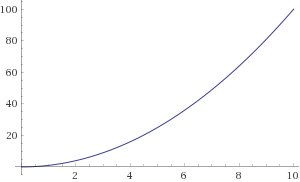It took me a couple of tries at F# (my first FP language, similar to Elm) before I could write in it, and a bit longer before I was writing using functional idioms. So don't feel bad. Elm (and FP)'s learning curve is harder compared to something like JavaScript, but it is worth learning. This is kinda the way I look at it in graphs.
Writing your first pure JS app is about like this. Super easy to start, but increasingly hard to recover from mistakes.
Writing your first Elm app is kinda like this (assuming no prior FP knowledge). Pretty hard to get started... maybe even have to "unlearn" some habits. But recovering from beginner mistakes (or changing requirements) is not particularly hard. Just normal work.
Also note that there are built-in helpers for Maybe. Totally optional to use, but a little shorter.
blankQuestion={question="",answers=[],correctAnswer=""}currentQuestion:MaybeQuestion->QuestioncurrentQuestionpossibleQuestion=Maybe.withDefaultblankQuestionpossibleQuestion-- or if you prefercurrentQuestionpossibleQuestion=possibleQuestion|>Maybe.withDefaultblankQuestion
We use Elm in production, and I am very happy with that choice. In fact, we trained two devs without prior professional experience (but with CS education) to use Elm. They were writing in it after a couple of weeks and doing features after a month. I think immersion and going through the learning process with others helps. After 1 month, this was obviously not the greatest Elm/FP code, but Elm is quite amenable to refactoring once you learn a better way.
Ah okay! I gave myself probably around 10 hours in total -- I'm not learning it for a job so it makes it harder to justify a huge time commitment! I do have Redux experience, though this was my first fully functional language. I was just proud that I had something working at the end! Maybe someday I will have more time to commit to learning FP more fully!
If you do get to the point that you want to make another attempt at an FP language, and you have some interest in .NET, then I highly recommend F# and The Book of F# by Dave Fancher.
F# is essentially OCaml for .NET, created by Don Syme of Microsoft Research Cambridge.
Unlike Elm, it isn't a pure FP language. (To be a first-class .NET language, it has to support .NET's OO paradigm.) But like Elm, it puts FP front-and-center.
For further actions, you may consider blocking this person and/or reporting abuse
We're a place where coders share, stay up-to-date and grow their careers.
It took me a couple of tries at F# (my first FP language, similar to Elm) before I could write in it, and a bit longer before I was writing using functional idioms. So don't feel bad. Elm (and FP)'s learning curve is harder compared to something like JavaScript, but it is worth learning. This is kinda the way I look at it in graphs.
Writing your first pure JS app is about like this. Super easy to start, but increasingly hard to recover from mistakes.

Writing your first Elm app is kinda like this (assuming no prior FP knowledge). Pretty hard to get started... maybe even have to "unlearn" some habits. But recovering from beginner mistakes (or changing requirements) is not particularly hard. Just normal work.

Also note that there are built-in helpers for
Maybe. Totally optional to use, but a little shorter.We use Elm in production, and I am very happy with that choice. In fact, we trained two devs without prior professional experience (but with CS education) to use Elm. They were writing in it after a couple of weeks and doing features after a month. I think immersion and going through the learning process with others helps. After 1 month, this was obviously not the greatest Elm/FP code, but Elm is quite amenable to refactoring once you learn a better way.
Ah okay! I gave myself probably around 10 hours in total -- I'm not learning it for a job so it makes it harder to justify a huge time commitment! I do have Redux experience, though this was my first fully functional language. I was just proud that I had something working at the end! Maybe someday I will have more time to commit to learning FP more fully!
If you do get to the point that you want to make another attempt at an FP language, and you have some interest in .NET, then I highly recommend F# and The Book of F# by Dave Fancher.
F# is essentially OCaml for .NET, created by Don Syme of Microsoft Research Cambridge.
Unlike Elm, it isn't a pure FP language. (To be a first-class .NET language, it has to support .NET's OO paradigm.) But like Elm, it puts FP front-and-center.